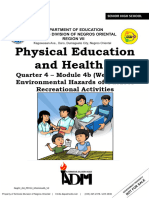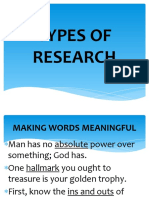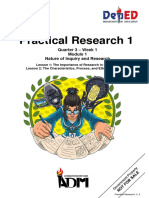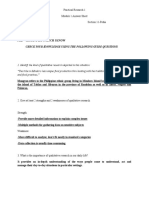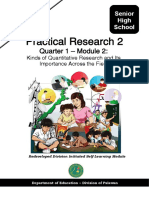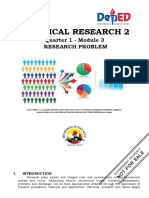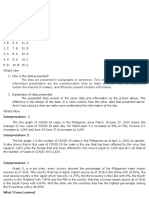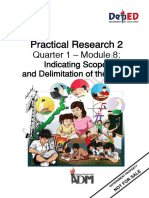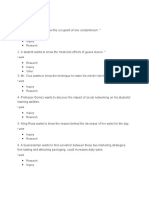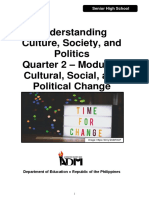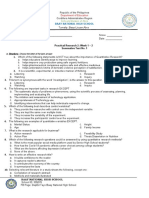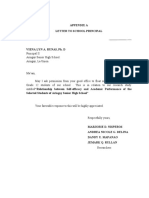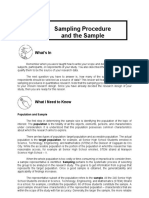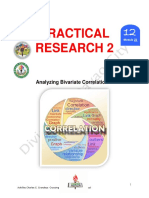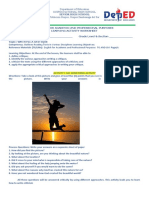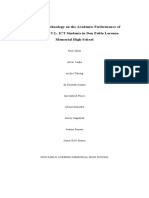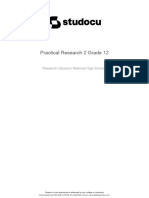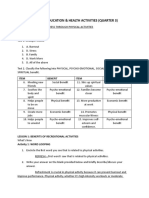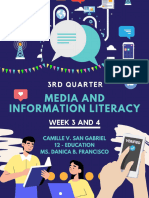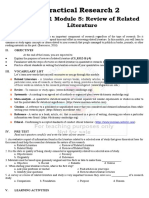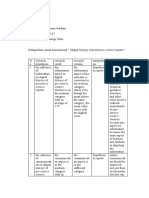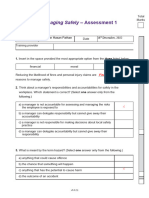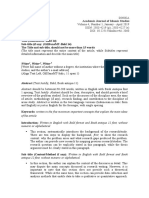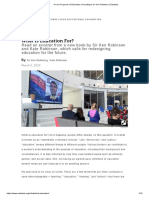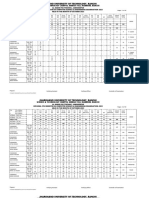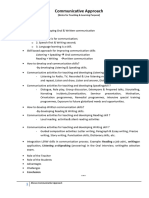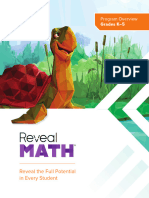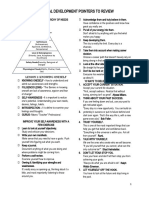PRACTICAL
12 RESEARCH 2
Quarter 1
LEARNER’S MATERIAL
� Module
Practical Research 2
1
PIVOT IV-A Learner’s Material
Quarter 1 Module 1 WEEK
First Edition, 2020
8
GRADE 12
Practical Research 2
Development Team of the Module
Author:
Editor:
Reviewer:
Illustrator:
Layout Artist:
Management Team:
1
�I What I need to know?
In this lesson, you will learn how to demonstrate an understanding of the
ethical standards in writing related literature .
Activity #1: Vocabulary Improvement
Direction: From the box, choose the word that is similar in meaning to the itali-
cized word in the sentence. Write you answer on the line provided.
1. I have varied suggestions for the success of our project, but for now, let Mr.
Lee’s suggestion prevail. ____________________________________________
2. Not checking the essential parts of your car is not a simple case, but a sign of
gross negligence. __________________________________________________
3. I know I have enough time and effort to stand the rigorous way of conducting
a research project. _ ________________________________________________
4. Please state with precision your final decision on the sale of the property
along the beach._ __________________________________________________
5. That’s the apt answer to his question._________________________________
6. Stay at home. Resort to calling up your friends only in times of
emergency.______________________________________________________
7. To make the plants yield fruits fast, water them regularly. _________________
NOTE:
Ilagay ang kahon na may kulay kapag hinhayaan ang mag-
aaral na sumagot sa sagutang papel
2
� I What is new?
Activity # 2
Directions: Be grand Speculators! Raise as many questions as you can about this
term: Review of Related Literature.
_________________________________________________________________
_________________________________________________________________
_________________________________________________________________
_________________________________________________________________
_________________________________________________________________
_________________________________________________________________
_________________________________________________________________
_________________________________________________________________
_________________________________________________________________
_________________________________________________________________
_________________________________________________________________
_________________________________________________________________
_________________________________________________________________
_________________________________________________________________
_________________________________________________________________
_________________________________________________________________
_________________________________________________________________
3
�D What I know?
Activity # 3
Directions: Answer the following questions concisely.
1. What is a review of related literature?
______________________________________________________________
______________________________________________________________
______________________________________________________________
______________________________________________________________
2. What is the role of your related literature in your research?
______________________________________________________________
______________________________________________________________
______________________________________________________________
______________________________________________________________
3. Why is it important to have a related literature in our research?
______________________________________________________________
______________________________________________________________
______________________________________________________________
______________________________________________________________
4
�D What is in?
Activity # 4:
Directions: Look for three examples of related literature in any book and
write down in the space provided below.
____________________________________________________________
____________________________________________________________
____________________________________________________________
____________________________________________________________
____________________________________________________________
____________________________________________________________
____________________________________________________________
____________________________________________________________
____________________________________________________________
____________________________________________________________
____________________________________________________________
____________________________________________________________
____________________________________________________________
____________________________________________________________
____________________________________________________________
____________________________________________________________
____________________________________________________________
____________________________________________________________
____________________________________________________________
____________________________________________________________
____________________________________________________________
____________________________________________________________
____________________________________________________________
____________________________________________________________
____________________________________________________________
____________________________________________________________
____________________________________________________________
5
�D What is it?
REVIEW OF RELATED LITERATURE (RRL)
RRL is an important component of research regardless of the type of research.
Be it qualitative or quantitative research, you spend time and effort in reviewing
related literature. Reviewing related literature is one major activity in research
that makes you examine or study again concepts or ideas related to your re-
search that people managed to publish in books, journals, or other reading mate-
rials in the past.
Purposes of RRL
Your reasons for reviewing related literature are true for both qualitative and
quantitative research. You re-examine written works related to your research for
the following purposes:
1. To find out the connection of your research to the current conditions or
situations of the world
2. To know more about theories or concepts underlying your research and to
learn from them with respect to your own research study
3. To discover the relation of your research with previous research studies
4. To obtain information on the accuracy or relevance of your research questions
5. To familiarize yourself with technical terms related to your research
RRL in Quantitative Research
You have learned that there are two basic methods of reviewing related litera-
ture: traditional and systematic review. Traditional is for qualitative research; sys-
tematic, for quantitative research. Systematic review, ‘a question-driven method-
ology’ is used by quantitative researchers who begin their research work by ask-
ing questions—one big question that states the main problem of the research
and a set of sub-questions that deal with specific aspects of the research.
Qualitative research likewise begins with research questions, but these are open
-ended and subjective questions, in contrast to quantitative questions that aim at
obtaining exact, specific, and objective answers whose origin or sources are
easy to trace. (Ridley 2012, p. 189; Jesson 2011)
6
�D What is it?
REVIEW OF RELATED LITERATURE (RRL)
Steps in Conducting a Systematic Review
Systematic review of related literature happens through the following sequential
steps:
1. Clarifying the research questions
2. Planning the research based on your understanding of the research questions
3. Searching for literature
4. Listing criteria for considering the values of written works
5. Evaluating the quality of previous research studies
6. Summarizing the various forms of knowledge collected
Obtaining results of the review of related literature by means of systematic
review that takes place in a step-by-step method is a scientific way of conducting
a re-examination of reading materials that have close connection with your re-
search.
Adopting a systematic review of related literature prevents you from being bias in
dealing with the varied form of literature. The adherence of systematic review to
scientific method makes it the apt RRL method for quantitative research that like-
wise follows the scientific method of looking into the truthfulness of something.
(Babbie 2013; Russel 2013; Jesson 2011)
Meta-analysis in Quantitative Research
What is meta-analysis in relation to RRL? Meta-analysis is a kind of review of related
literature in which you re-examine and combine the results of two or more statistical
studies for coming out with a grand total to indicate stronger effects of the research
outcome. Putting the results together and making them appear as one result work to
strengthen whatever impact the independent variable has on the dependent variable.
7
�D What is it?
REVIEW OF RELATED LITERATURE (RRL)
Meta-analysis helps in guaranteeing the precision of the measuring method used
in a quantitative research. However, this merging of statistical results is not appli-
cable to all quantitative research studies. You resort to meta-analysis only if the
statistics that you intend to combine come from studies having several similari-
ties like they are comparable in terms of research questions, research design,
treatment, measuring technique, and measurable outcome. Similar in many
ways, these studies that are apt for combination purposes are called homoge-
nous studies. Conversely, with a number of differences from other studies, they
are called heterogeneous studies and are exempted from this type of systematic
review of related literature called meta-analysis.
The qualitative approach of narrative synthesis which is a systematic review
using written verbal language to explain or describe test results is the appropri-
ate RRL method for heterogeneous studies. The meta-analysis systematic re-
view prevails strongly in the field of medicine where researchers must conduct
studies to yield medicines that, supported by sufficient evidence, are capable of
reaching their certainty level. (Ridley 2012; Jesson 2014)
In-text Citation and Referencing Styles
All reading materials related to your research that you intend to review or
re-examine offer you concepts, ideas, or information belonging to other people.
Having honesty, respect, or courtesy to the owners of these varied forms of
knowledge as well as gratefulness for their valuable contribution to the field, you
see to it that the names of these idea owners or authors appear in the appropri-
ate sections of your research paper.
8
�D What is it?
REVIEW OF RELATED LITERATURE (RRL)
Other people’s ideas incorporated in the central section or main body of your
paper are to be cited or referred to the true owners of borrowed ideas. Referring
to authors within the main body of the paper is called Citation or In-text Citation;
at the end of the paper, it is called Bibliography or References. The two most
commonly used referencing styles are the MLA (Modern Language Association)
and the APA (American Psychological Association). The following table shows
you how these two referencing styles differ in some aspects.
Examples of MLA Referencing Style
1. Citation or In-text Citation
(Zobel 287)
(Lopena, Torres, Bado 90–150)
(Carlos et al. 134–150)
(Gorio: 1: 66–70)
2. Documentary Notes
The same as the entries in a bibliography or References, except that, here, the
first name precedes the family name of the author.
Fely Decena, G. Globalization. Quezon City: GB Press. 2016
Mariano Lopez. Tropical Depressions.
9
�D What is it?
REVIEW OF RELATED LITERATURE (RRL)
3. Bibliography/References
One author
Decena, Fely G. Globalization. (Quezon City: GB Press. 2016).
Lopez, Mariano. Tropical Depressions. (Manila: Adarna Publishing
House, 2016).
Two Authors
Certeza, Nina C. and David, Jose L. Intercultural Competence. (Baguio
City: KLM Co., 2018).
Ramos, Hilario R. and Benitez, Rosie M. Academic Competitions. (Manila: National Bookstore,
2016).
Three Authors (List down the names in the order they appear in the title page.)
Perez, Dino A., Mista, Dora C. and Paluan, Gloria F. Carcinogenic- Foods. (Pasay City: ABC Press,
2016).
Flores, Lauro D. Aranda, Ben C., and Ferrer, Socorro V. The Manila Voters. (Quezon City: Abiva
Publishing House, 2016).
Materials through Computers
1. Signed article in a magazine
Smith, Robert. “Email Craze.” Interactions. July 2016.
http://www.inter.com/Jol/labor.htm/
2. Unsigned article in a magazine
“Power Interview.” Business Trends Magazine. August 2016.
<http://www.BusTRendscom/Bus Trends/Trends/ctshoot.htmlz>
3. Article in Journal
“Systemic Functional Grammar.” English Forum. 38.7(2016). 18 May 2016.
<http://www.jhu.edu/English Studies Journal/vol.83/83.1 strethson.htmlz.
10
�D What is it?
REVIEW OF RELATED LITERATURE (RRL)
Examples of APA Referencing Style
1. Citation or In-text Citation
(Lopena, 2016) (Olivarez, 2017)
(Cortez, Mabeza, Brado, 2016, pp. 120–130)
(Ligos et al., 2016)
According to Flores (2017)…
Olidan (2016) maintains that...
A study on the Pork Barrel Scam is a “doable research work”
(Abunda, 2016, p.78)
2. Bibliography/References
One author
Floro, J. A. (2016). The Colds Virus. Quezon City: GB Press.
Gorrez, B. M. (2017). The Philippine Educational System. Manila: Adarna Publishing House.
Two Authors
Oropesa, N. C. and Danes, J. L. (2017). Coron Islands. Baguio City: KLM
Company.
Reylado, M. R. and Sabando, J. M. (2017). Academic Institutions.
Manila: National Bookstore.
Three Authors (List down the names in the order they appear in the title page.)
Regalaa, C. A., Bautista, C. C. and Laya, G. F. (2017). The Philippines’
Supreme Court Justice. Pasay City: ABC Press.
Agoda, J. D. Oracia, B. C., and Torres, S. V.(2017). The Rescuers of
super-typhoon Yolanda. Quezon City: Abiva Publishing House.
11
�D What is it?
REVIEW OF RELATED LITERATURE (RRL)
Materials through Computers
1. Signed article in a magazine
Alegre, R. ( July 2016). “Social-media networks.” Personality growth. Retrieved
from http://www.inter.com/Jol/labor.htm/
2. Unsigned article in a magazine
“Unstructured interview. (August 2016).” Business Trends Magazine.
Retrieved from http://www.BusTRendscom/Bus Trends/Trends/ctshoot.htmlz.
3. Article in Journal
“Linguistic competence. (18 May 2016).” English Forum. Retrieved from
http://www.jhu.edu/English Studies Journal/vol.83/83.1strethson.htmlz.
4. Article in Newspaper
Davalos, J. “ The era of globalization.” (21 December 2016). New Daily Life Star. Retrieved from
http://www.nytimes.com/2016/26 world/28 MIDE.htmlz.
5. An Editorial
“Politics in the Philippines. (7 July 2016).” Editorial. Philippine Daily Inquirer.
Retrieved from http://www.a-pinq.com/ed/2016/24/po4.htmlz/
6. Online books
Silverman, F. D. (2016). American pragmatics. Retrieved from http: AMPRA 2
etext2014/14w0310txtz.
Forbes, J. G. (15–20, May 2017). “Non-verbal language.” Retrieved from dialog ERIC AED23376.
12
�D What is it?
REVIEW OF RELATED LITERATURE (RRL)
Ethical Standards in Literature-Review Writing
Nowadays, with the advent of modern technology causing the emergence
of varied electronic communication devices and online sources of information,
collecting data happens easily and speedily. Through computer technology with
its powerful Internet, you become exposed to extensive amount of knowledge
that is so easy to lure you into practicing the copy-and-paste technique of obtain-
ing ideas for your research you may fall into this dishonest way of reviewing and
writing related literature.
The ethical way of literature writing tells you to acknowledge the owners of
borrowed ideas and put quotation marks around copied words from books or arti-
cles. Intentionally or negligently disregarding the use of quotation marks around
words copied exactly is not only unethical but an indication of gross plagiarism
as well. You must be aware of the fact that with the surfacing of online sources
of information, software to detect plagiarism from online sources has likewise be-
come so available in academic institutions. Proper citation and referencing is
your way of freeing yourself from plagiarism and of avoiding people from casting
doubts on your honesty and integrity as a researcher. (Fraenbel 2012; Ransome
2011)
13
�E What is more?
Activity # 5
Directions: Fill in the blanks with correct answers to complete the text.
Review of related literature happens in two ways: (1) _______ and systematic
review. Systematic review is for (2) __________; traditional for qualitative re-
search.
A review of statistical results makes you use (3) _________ kind of systematic
review.
All test results are applicable to (4) _______’ except those coming from (5)
__________ studies. (6) ______ review through meta- analysis are given by (7)
________studies, not by (8) _________ that are characterized by dissimilar re-
search aspects. Whatever studies the statistical results come from, these should
be (9) ______ -based results; meaning they are based on facts. Not giving im-
portance to proofs or evidence, you resort to presenting literature review results in
(10) ________.
14
� E What I can do?
Activity 6:
Directions: INDIVIDUAL WORK. Graphically, show in the space provided the
taking place of a systematic review of literature.
15
� E What else can I do?
Activity # 7:
Directions: Put a check mark before the correct answer.
1. Meta-analysis supports a review of related literature that is:
________ traditional
________ systematic
________ technical
________ total
2. A systematic review of related literature follows a certain:
________ theory
________ method
________ instruction
________ model
3. Being honest, truthful, and grateful in doing the review of related literature is
practicing:
________ smartness
________ cut-and-paste
________ ethics
________ individualism
4. Referencing within the body of the paper gives you this research-paper
component:
________ footnotes
________ bibliography
________ references
________ citation
5. Quantitative research uses meta-analysis; qualitative research uses:
________ narrative synthesis
________ discourse analysis
________ data analysis
________ thematic synthesis
16
�A What I have learned?
Activity # 8:
Directions : Check the right column for each referencing item.
17
�A What I can achieve?
Activity # 9
Directions: Follow the direction carefully.
In a brief reflective essay, express how much you understood the concepts about
the RRL or Review of Related Literature in a quantitative research. Specify which ideas
sank into your mind or came to your understanding excellently, moderately, slightly,
poorly, or emptily.
_______________________________________________________________________
_______________________________________________________________________
_______________________________________________________________________
_______________________________________________________________________
_______________________________________________________________________
_______________________________________________________________________
_______________________________________________________________________
_______________________________________________________________________
_______________________________________________________________________
_______________________________________________________________________
_______________________________________________________________________
_______________________________________________________________________
_______________________________________________________________________
_______________________________________________________________________
_______________________________________________________________________
_______________________________________________________________________
_______________________________________________________________________
_______________________________________________________________________
18
� Answer
Activity# 1– Answers vary
Activity# 2– Answers vary
Activity# 3– Answers vary
Activity# 4– Answers vary
Activity# 5– Answers vary
Activity# 6– Answers vary
Activity# 7– Answers vary
Activity# 8– Answers vary
Activity# 9 Answers vary
19
� Reference
Baraceros, Esther L. Practical Research 2, First Edition, Rex Book Store, Inc.
(RBSI) 856 Nicanor Reyes Sr. St., Sampaloc, Manila , 2016.
20






